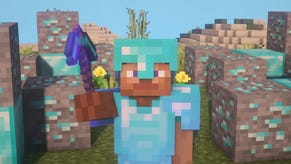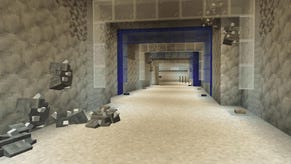How Has Microsoft Changed Minecraft?
For Better Or Worse
Stepping into the main hall at Minecon, the huge annual get-together for Minecraft fans all over the world, you wouldn't know that Microsoft existed - much less that it paid $2.5 billion dollars to acquire Mojang less than a year ago. The only sign of the multinational software giant's presence is a monochrome rendition of its logo on the shoulders of its staffers. A logo which, coincidentally, is four flat blocks. Most people probably aren't even aware the company is there at all.
Since the Mojang acquisition, Microsoft has very carefully stayed in the shadows to avoid spooking the game's tens of millions of enthusiastic players. At this year's Minecon I spoke to Mojang staff and Minecraft fans to find out how the acquisition has affected one of the world's most popular games.
When I ask people around the hall how the game had changed since the buyout, most say that it hasn't changed at all - hastily adding "And that's a good thing!" Microsoft doesn't have a good track record when it comes to these things, y'see. The company has made a lot of gaming acquisitions in the past, and most have subsequently failed to live up to their prior successes. FASA Interactive, Bungie, Digital Anvil, Ensemble Studios, Rare, Lionhead - the list of games studios chewed up and either spat out or "redistributed" within the organisation is lengthy.
The key question on the lips of Minecraft fans now is whether it'll be different this time round. Mojang is an unusual beast compared to many of those other acquisitions - the studio is far smaller, but Minecraft itself is far, FAR more popular than anything Microsoft has ever owned. Bringing the Mojang team under the auspices of Microsoft without snuffing out its unique culture is no easy task, but Microsoft's hands-off approach so far seems to be working. When Mojang's COO Vu Bui thanked the company from the stage during the Minecon closing ceremony I listened out carefully for even the slightest heckle or display of displeasure, but heard only polite applause.
"We've been partners with them for many years, since we launched on the Xbox 360," Mojang's poker-faced CEO Jonas Mårtensson reminds me, when I grab him for a short interview during a break between Minecon panels on a balcony overlooking the Thames. "Microsoft obviously bought it because it's a great game and it's a great community. They don't want to destroy that. They're committed to invest in the game and to growing the community." Minecraft developer Nathan 'Dinnerbone' Adams adds in a later interview: "Initially everyone was really scared. I totally understand that - I was scared, I'll admit that to anyone who asks. But I think as time goes on, people have kinda realised that actually nothing really has changed. There have actually been good things that have come out of it."
One of those good things has been the version of Minecraft running on Microsoft's augmented-reality 'Hololens' headset. The E3 demo of the technology, where a Minecraft world came to life on a dining table, blew the internet's collective minds - and having experienced it personally myself at Minecon, I can tell you that it wasn't a carefully-choreographed, on-rails demo - it really is a full version of Minecraft running in there, albeit one derived from the Pocket Edition of the game.
The Hololens version is also the same version of the game that was recently announced as the 'Windows 10 Edition beta' - which no doubt caused some confusion among fans as to how it relates to the existing PC version. "The Windows 10 version is compatible with Pocket Edition, so you can play with your friends on Pocket Edition," says Dinnerbone when I ask him to clarify the relationship between the two. The way he tells it, the existing PC version is still the flagship version of Minecraft: "For people who want to play on PC servers, or use mods, then the PC edition is strong and alive and that is the version we recommend."
The other area, alongside the Hololens, where Microsoft's resources are being keenly felt is in the Pocket Edition. The mobile phone and tablet edition of the game has long lagged behind the desktop version in terms of features, but suddenly it's catching up fast - the next update will add the entire Nether dimension, as well as potion brewing mechanics, the ability to crouch and sprint and - before the end of the year - the long-awaited addition of redstone circuitry. The eventual goal is to have one version of Minecraft that everyone plays across all platforms. "It doesn't matter where you're playing it, who you're playing it with, it's just Minecraft," Dinnerbone says. "That's the ultimate goal - I'll play on my computer, you'll play on your phone. We'll be halfway across the world. It doesn't matter - we'll just play."
In terms of Mojang's internal organisation, the biggest change is the addition of a new Minecraft team operating out of Microsoft's headquarters in Redmond, Washington which is working on all of this stuff. I ask Dinnerbone how much influence that team has on the direction the game is taking: "They have influence, as much as anyone else - which is that we can talk about it," he says. "Obviously they're involved and they have feedback. But they're helping us making it bigger and better for the community," adds Mårtensson. The final decisions are still made in Stockholm, though - mostly by Jens - the tall, Swedish coder who was handed the 'lead developer of Minecraft' reins by Notch way back in 2011. "If there ever needs to be a final 'I have veto rights', it's Jens," says Dinnerbone. "But for most things we all kinda align on the same idea and direction."
Minecraft isn't Mojang's only game of course. It also publishes an action platformer called Cobalt and was until recently developing a digital card game called Scrolls. I ask Mårtensson whether the Scrolls decision had anything to do with Microsoft and get an immediate, flat "Not at all" in response. Poking a little, I ask if Mojang will continue to publish non-Minecraft games. "I wouldn't want to put it out as a promise," he says. "I'm hoping eventually that we can put out more games, but I wouldn't go out and say that's a promise."
In terms of Microsoft's attitude towards Minecraft fans, the ultimate test is still to come - particularly when it comes to long term support of competing platforms like the Playstation edition of the game. When the acquisition happened, many expected that those versions would slowly fade away - but to the surprise of many Minecon attendees, Microsoft's booth at the event hosted several Playstations running Minecraft. "I think that kinda shows that they're not here to be intimidating, they're not here to be (adopts robot voice) 'Windows is the best. Buy Xboxes.'" says Dinnerbone, when I ask about Microsoft's presence. "They're here just to show, like: "we exist, we help with this stuff. Here it is, you can play here and here. Isn't that cool?'"
For the fans, opinions differ. Whilst everyone I spoke to at the convention was aware of the Microsoft buyout, most told me there'd been no noticeable change. Only a few were a little more forthright. "It hasn't changed as much as it should for $2.5 billion," say Michael and Alex, a pair of young fans from Strood, but Ben and Emilie from North Carolina were more sanguine: "It'll bring discipline, and Microsoft's deep pockets will ensure its future," they say. "Minecraft has grown up."







_2560x1440.png?width=291&height=164&fit=crop&quality=80&format=jpg&auto=webp)






